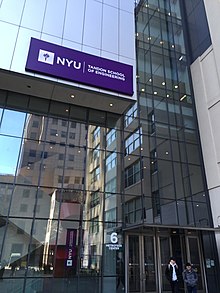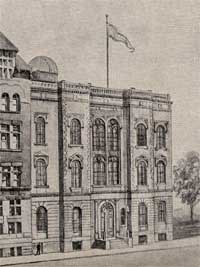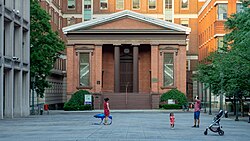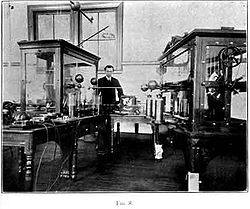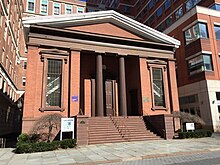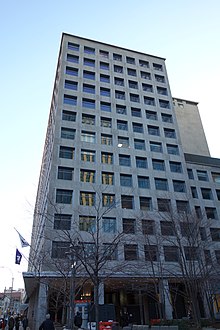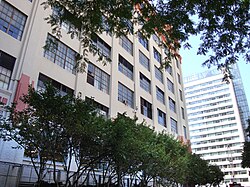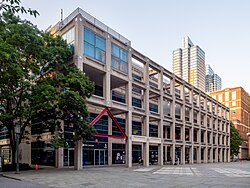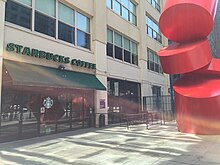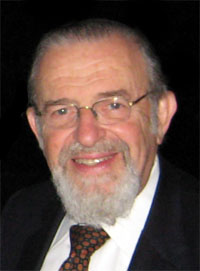
The New York Institute of Technology is a private research university founded in 1955. It has two main campuses in New York—one in Old Westbury, on Long Island, and one in Manhattan. Additionally, it has a cybersecurity research lab, a biosciences, bioengineering lab and the Entrepreneurship and Technology Innovation Center which has close links to NASA, in Old Westbury, as well as campuses in Arkansas, China, and Canada. The U.S. Department of Defense and the U.S. Department of Homeland Security designated NYIT as a National Center of Academic Excellence in Cyber Defense Education.
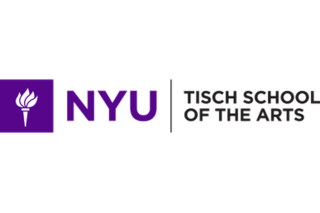
The New York University Tisch School of the Arts is the performing, cinematic and media arts school of New York University.
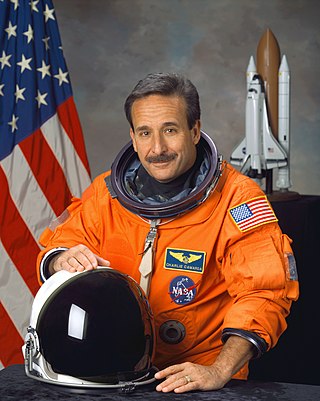
Charles Joseph "Charlie" Camarda is an American engineer and a NASA astronaut who flew his first mission into space on board the Space Shuttle mission STS-114. He served as Senior Advisor for Engineering Development at NASA Langley Research Center. and was a senior advisor for innovation at the office of Chief Engineer in the Johnson Space Center.

Brooklyn Commons, formerly MetroTech Center, is a business and educational center in Downtown Brooklyn, New York City.
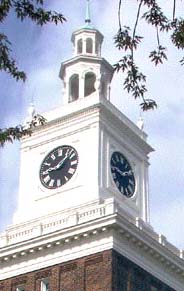
Poly Prep Country Day School is an independent, co-educational day school with two campuses in Brooklyn, New York, United States. The Middle School and Upper School are located in the Dyker Heights section of Brooklyn, while the Lower School is located in Brooklyn's Park Slope neighborhood. Initially founded as part of the Brooklyn Collegiate and Polytechnic Institute, Poly Prep now offers classes from nursery school through 12th grade.
The Leonard N. Stern School of Business is the business school of New York University, a private research university based in New York City. Founded as the School of Commerce, Accounts and Finance in 1900, the school received its current name in 1988.

Florida Polytechnic University is a public university in Lakeland, Florida. Created as an independent university in 2012, it is the newest of the 12 institutions in the State University System of Florida. It is the state's only public polytechnic university, and focuses solely on STEM education.
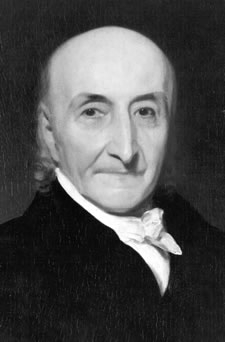
The history of New York University begins in the early 19th century. A group of prominent New York City residents from the city's landed class of merchants, bankers, and traders established NYU on April 18, 1831. These New Yorkers believed the city needed a university designed for young men who would be admitted based on merit, not birthright or social class. Albert Gallatin, one of the founders of the university, described his motivation in a letter to a friend: "It appeared to me impossible to preserve our democratic institutions and the right of universal suffrage unless we could raise the standard of general education and the mind of the laboring classes nearer to a level with those born under more favorable circumstances." For the school's founders, the classical curriculum offered at American colonial colleges needed to be combined with a more modern and practical education. Educators in Paris, Vienna, and London were beginning to consider a new form of higher learning, where students began to focus not only on the classics and religion, but also modern languages, philosophy, history, political economy, mathematics, and physical science; so students might become merchants, bankers, lawyers, physicians, architects, and engineers. Although the new school would be non-denominational – unlike many American colonial colleges, which at the time offered classical educations centered on theology – the founding of NYU was also a reaction by evangelical Presbyterians to what they perceived as the Episcopalianism of Columbia College.

Jerry MacArthur Hultin was the United States Under Secretary of the Navy from 1997 to 2000. He was the president of the Polytechnic Institute of New York University from 2005 until 2012. He is currently the Chairman of the Global Futures Group, which advises cities, states and countries on best practices in smart city development.

NYU Tandon Digital Learning, formerly known as NYU Tandon Online and NYU-ePoly, is the digital learning department at New York University Tandon School of Engineering, a noted school of engineering, technology, management and applied sciences in the United States.

The State University of New York Polytechnic Institute is a public university with campuses in Marcy, New York. It is part of the State University of New York (SUNY) system. Founded in 1966 using classrooms at a primary school, what became SUNY Poly is New York's public polytechnic college. The Marcy campus, formerly the SUNY Institute of Technology, has a Utica, New York mailing address and was established in 1987.
Theodore (Ted) Scott Rappaport is an American electrical engineer and the David Lee/Ernst Weber Professor of Electrical and Computer Engineering at New York University Tandon School of Engineering and founding director of NYU WIRELESS.

Michael Horodniceanu was a Romanian-born American civil engineer who served as traffic commissioner of New York City. He was also the president of MTA Capital Construction.
Maurizio Porfiri is an engineering professor, mostly noted for his work with robotic fish and aquatic research. His research revolves around modeling and control of complex systems, with applications from mechanics to behavior, public health, and robotics. He is an Institute Professor of Mechanical and Aerospace Engineering and Biomedical Engineering at the New York University Tandon School of Engineering. He is also part of the core faculty of New York University's Center for Urban Science and Progress. In 2022, he was appointed the director of the Center for Urban Science and Progress.

Robert Ubell is the former Vice Dean of Online Learning at New York University Tandon School of Engineering, where he headed the school's e-learning unit, NYU Tandon Online, formerly known as NYU-ePoly. He is currently Vice Dean Emeritus, Online Learning at NYU Tandon Online. Under his leadership, NYU Tandon Online has grown in size and stature, achieving more than 10,000 enrollments since it was first launched. Since 2013, US News & World Report has ranked the unit's online engineering graduate program in the top dozen in the nation and in 2015, ranked it as No. 8. In the same year, NYU Tandon Online was the recipient of the Ralph E. Gomory Award for Quality Online Education from the Online Learning Consortium
Nasir Memon is a computer scientist based in Brooklyn, New York. Memon is a professor and chair of the New York University Tandon School of Engineering computer science and engineering department and affiliate faculty at the computer science department in the Courant Institute of Mathematical Sciences at New York University. He is also the Department Head of NYU Tandon Online, the online learning unit of the school. He introduced cyber security studies to New York University Tandon School of Engineering, making it one of the first schools to implement the program at the undergraduate level. Memon holds twelve patents in image compression and security. He is the founding director of the Center for Interdisciplinary Studies in Security and Privacy (CRISSP) and CRISSP Abu Dhabi. In 2002, Memon founded Cyber Security Awareness Week (CSAW), an annual conference where tens of thousands of students compete in events and learn skills in cyber security Memon is also co-founder of Digital Assembly, a software company that develops digital forensics and data recovery and Vivic, a company that produces malware detection software. Memon has published over 250 articles in journals and conferences and has contributed to articles regarding cyber security in magazines such as Crain’s New York Business, Fortune, and USA Today. His research has been featured in NBC Nightly News, The New York Times, MIT Review, Wired.Com, and New Science Magazine.
Jeffrey P. Freidberg was head of the Nuclear Science and Engineering Department at Massachusetts Institute of Technology from 1997 to 2003. He is currently Professor of Nuclear Science and Engineering (Emeritus) at MIT, and a collaborator at NYU's Courant Institute of Mathematical Sciences. He retired as associate director of MIT Plasma Science and Fusion Center and from his academic duties in 2011. He remained involved in the research activities of the PSFC Theory Group and wrote a new textbook on magnetohydrodynamics theory called Ideal MHD that was published in 2014. He is also author of a book titled Plasma Physics and Fusion Energy first published in 2007, that was based on a series of course notes from MIT graduate courses on plasma physics and fusion energy.
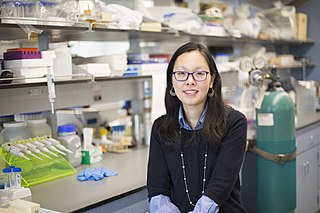
Jin Kim Montclare is a Professor of Chemical and Biomolecular Engineering at New York University. She creates novel proteins that can be used in drug delivery, tissue regeneration and as medical treatment. She is a 2019 AAAS Leshner Leadership Fellow and has been inducted to the AIMBE College of Fellows.
